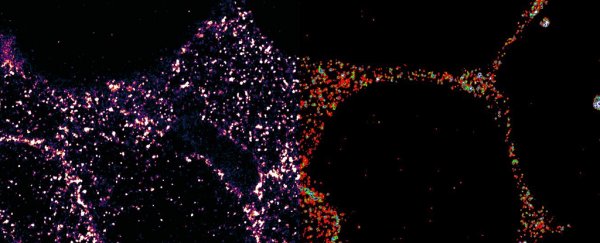For the first time, scientists just got a high-resolution look at a protein closely linked to type 2 diabetes, a feat that could increase our understanding of the mechanisms behind the widespread condition, and advance the development of new treatments.
The protein in question is the glucagon-like peptide-1 receptor (GLP1R), which helps to control blood sugar levels by encouraging the pancreas to release more insulin, stopping the liver from producing too much glucose, and reducing appetite.
That combination means it's already a main target for the treatment of type 2 diabetes, but its small size means it's hard to visualise. The researchers hope that this close-up look at GLP1R is going to help improve the drugs designed to interact with it.
 GLP1R visualised in insulin-secreting beta cells at super-resolution. (University of Birmingham)
GLP1R visualised in insulin-secreting beta cells at super-resolution. (University of Birmingham)
"Our research allows us to visualise this key receptor in much more detail than before," says cellular biologist David Hodson from the University of Birmingham, UK. "Think about watching a movie in standard definition versus 4K, that's how big the difference is.
"We believe this breakthrough will give us a much greater understanding of GLP1R distribution and function. Whilst this will not immediately change treatment for patients, it might influence how we design drugs in the future."
The researchers used a combination of high-resolution microscopy and fluorescent tagging techniques to come up with the finished images; specifically, they designed a new far-red fluorescent peptide tag called LUXendin645 to attach itself to GLP1R in both human beta cells and in live mice.
Fluorescent tags have been incredibly important in biological imaging since their discovery, but until now, it was a struggle to find one to attach specifically to GLP1R without activating other, unhelpful parts of the cell.
"We therefore set out to generate a specific probe for endogenous GLP1R detection in its native, surface-exposed state in live and fixed tissue, without receptor activation," the team explains.
Through the use of their custom fluorescent probes, GLP1R was made visible to high-resolution imaging techniques, revealing both its location in cells and its response to certain triggers from other molecules.
Further down the line, these high-res pictures could lead to drugs that are able to better manage type 2 diabetes, because we have a better understanding of one of the key receptor proteins controlling blood sugar.
GLP1R is one of a group of G protein-coupled receptors (GPCRs), which have already given drug developers plenty of targets to aim at. It's estimated that between a third and a half of all marketed drugs act by binding to one of the GPCRs.
"Our experiments, made possible by combining expertise in chemistry and cell biology, will improve our understanding of GLP1R in the pancreas and the brain," says chemist Johannes Broichhagen, from the Max-Planck Institute for Medical Research in Germany.
"Importantly, our results suggest a degree of complexity not readily appreciated with previous approaches."
The research has been published in Nature Communications.
